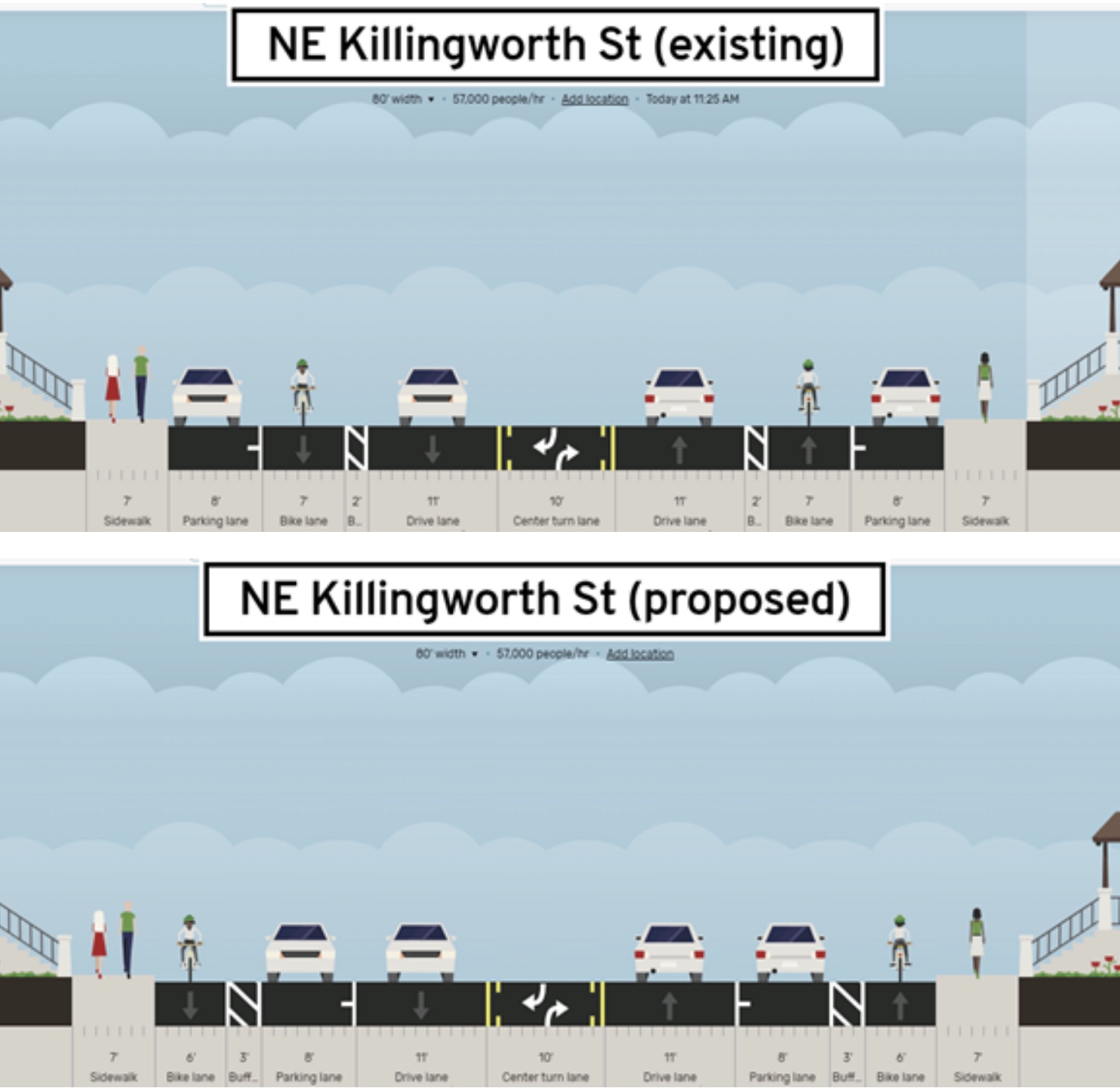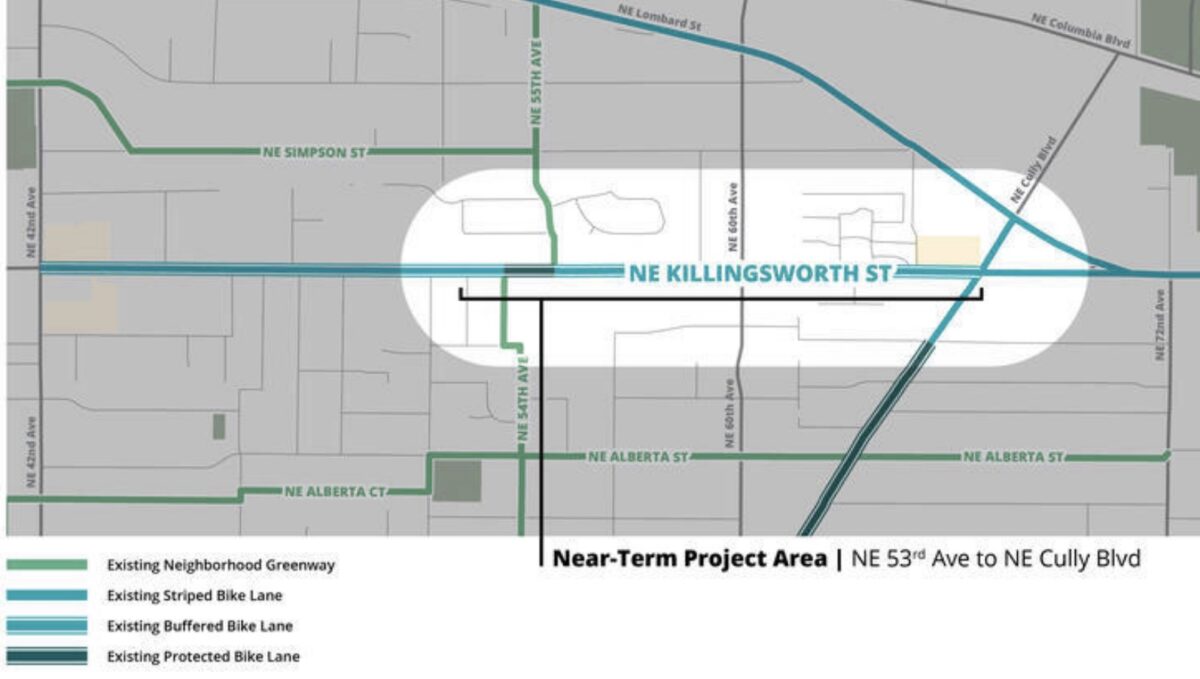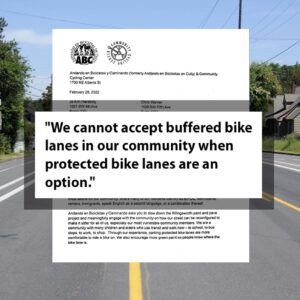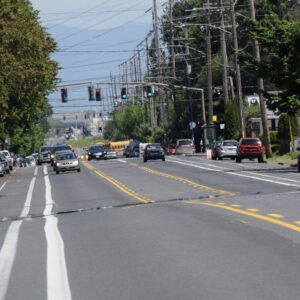On Monday afternoon, City Commissioner Jo Ann Hardesty, announced that the Portland Bureau of Transportation would heed demands from Cully neighborhood and safe streets advocates and build more robust bike lanes on Northeast Killingsworth than were initially planned.
When PBOT first looked at the 0.7-mile segment of Killingsworth between 53rd and Cully Blvd (see map), they decided it needed repaving. The initial design called for replacing the existing lane configuration with what’s there now — door-zone bike lanes with an additional painted (unprotected) buffer between riders and other road users. But in February, neighborhood residents spurred to action by advocacy group Andando en Bicicletas y Caminando (ABC, translates to “riding bikes and walking”) with support from Community Cycling Center, told PBOT they wanted more. In a joint letter to Commissioner Hardesty and PBOT Director Chris Warner, they said, “We cannot accept buffered bike lanes.”
Buffered bike lanes are cheaper and easier for PBOT to implement and they don’t require one of the things the agency is often most reluctant to do: ask for a neighborhood’s support for a better bike lane that would reduce the amount of on-street car parking. PBOT was supportive of the advocates’ request from the get-go, but it took these groups speaking up to stop the bureaucratic inertia and create the potential for something better.
This advocacy led to a pause in the project from PBOT so they could conduct a formal outreach process and vet a different design proposal — one that would separate the bike lane from other lanes via a lane of parked cars and a more robust buffer zone. Because this parking-protected bike lane proposal would be a more significant change to the street, and because it would require a 50% reduction in on-street car parking spaces in a part of the city with a higher than average amount of low-income residents and Spanish-speaking people, PBOT moved forward carefully.
To make sure their new proposal was supported by community that would be most impacted by it, PBOT sent over 4,000 postcards to mailboxes in the area, launched an online survey, and hired a contractor (Living Cully Coalition) to organize two neighborhood meetings to collect feedback.



The response was resounding support for safer bicycling and the parking-protected lane. 75% of the 151 survey participants (63% of whom lived in the Cully neighborhood) felt the proposed design would meet project goals. A whopping 95% of respondents said the two most important priorities should be safer crossings and better bicycling facilities.
The result is a $4.1 million project that will bring significant changes to Killingsworth. In addition to the smoother pavement and parking-protected bike lanes between 53rd and Cully, PBOT says the project will include (descriptions from PBOT):
- Pedestrian signal rebuild and median islands midblock between 54th and 55th avenues. This project element was changed in response to community feedback. The project team originally proposed to remove the aging signal and replacing it with median islands. The signal will be rebuilt and median islands will still be added.
- Pedestrian crossing improvement with refuge islands and lighting enhancements at 64th Avenue. This project element was changed to serve the nearby manufactured home community and in response to a serious crash involving a pedestrian a few years ago.
- Transit platform with bikes up and over behind the platform at the eastbound 64th Avenue TriMet bus stop. This project element was added in response to community concerns about parking loss. The transit platform will help retain some parking in an area with higher-density, low income housing. The platform will also allow the frequent Line 72 bus to stop in lane, reducing delay, and separates bikes and buses from each other, reducing conflicts.
“I am proud that we took a step back to deepen our outreach – part of which was to include more residents who don’t speak English as a first language,” said Commissioner Hardesty in a statement yesterday.
Community Cycling Center Programs Director William Francis shared thoughts about the project with us this morning. “ABC members are proud and pleased to see that their participation in feedback sessions and conversations with PBOT have resulted in real infrastructure changes that center the well-being and safety of both cyclists and pedestrians along Killingsworth St. It is critical to amplify the voices of community-based groups like ABC because they stand up for some of the most vulnerable and overlooked users within the transportation system, and without their presence the status quo faces little opposition.”
And Marlene Canche, a member of ABC said (in Spanish, translated by PBOT), “I think it is good that they are putting in more marked crosswalks on Killingsworth. It is also good to have more separation between vehicles and cyclists. I feel safer as a cyclist and a pedestrian with that separation. But I think a change in driver behavior is also necessary because in the end they have to respect the crosswalks in order to truly keep people safe in Cully.”
Construction is due to start and be completed in 2024.
Learn more about the project on PBOT’s website.









Thanks for reading.
BikePortland has served this community with independent community journalism since 2005. We rely on subscriptions from readers like you to survive. Your financial support is vital in keeping this valuable resource alive and well.
Please subscribe today to strengthen and expand our work.
This is great news! And it’s great to hear about ABC and the work they are doing. I’m curious to know about other walking and bicycling-focused groups in neighborhoods and serving Portland’s underrepresented communities.
Lots of working class folx don’t have off street parking. I wonder how this parking reduction will impact the POC in this neighborhood? I wonder if ABC really speaks for this neighborhood?
True, though this areas looks ‘pretty good’ for off street/ side street parking supply vs parking demand.
The Google images looks like the demand should be met by the parking supply (50% reduction) if placed on one side…BUT this would need more frequent safe pedestrian crossings. The highest parking demand areas may be tied to staff parking at several commercial businesses near Cully that also have off street lots. (From my past experience doing parking studies… a lot of drivers with off street/ side street parking options often choose to park on the arterial street since its just more convenient OR their employer does not allow smoking on property – schools etc.) A more formal parking study should suss out where the demand is and where it is not (or where drivers do not park because its not safe due to side swipe crashes etc.) etc.
PBOT wondered the same thing, which is why they paid a local contractor to organize two meetings that featured almost a dozen n’hood groups (in addition to ABC) to present them with the facts about the impacts to parking and hear what they thought about it. And people still overwhelming supported the project because no one wants to live next to a car-centric street and when presented with a choice to do something about it they’ll vote against cars 99% of the time (IMO). Amazing huh?!!
Working class people are also less likely to have a car at all!
Or just one for a whole household. Whereas an average household is north of that.
Source: https://housegrail.com/how-many-cars-does-the-average-american-own/
Please don’t try to speak for all working class people. Many rely on automobiles to get to work and feed their families.
That’s not what he said, at all. You seem like you have an axe to grind here.
And many can’t afford a car for every member of the household, so they need a safe way to ride a bike or take transit to work.
Yeah, let’s not forget that parking reduction is based off todays numbers and not the mega housing units that we will eventually see in places like Cully. RIP will change all of this forecasting that the city is “falsely” projecting. All that really does is make people in todays world feel better.
I wish they would first extend this bike lane to the west (all the way to bluffs at Willamette). And on the east end, protect the current deathtrap bike lane on Lombard to 205.
Is anyone aware of any safety studies that show if the proposed treatment is in fact safer than the existing design? I am very afraid of right-hooks and getting hit by drivers exiting driveways when I’m not where drivers expect vehicles and am instead hidden away out of sight behind a row of parked cars.
I know non-cyclists *think* this design is safer, but many riders I know are convinced it’s not.
I’m not convinced this is safer. Parking “protected” bike lanes hide cyclists from motor traffic, which can lead to surprises at intersections. Drivers pulling out into the street will block the bike lane while they creep up to see around the parked cars.
That image from NE Glisan looks terrible — so confusing.
That sounds like perception vs reality. I’ve seen plenty of research that protected bike lanes are safer overall even though they have these visibility issues. It just means they need to be carefully designed to have good sight distance. And “regular” bike lanes have visibility issues too, in that drivers do not tend to check their rear-view mirrors and have to crane their necks to check for a bike. I feel like I get nearly right-hooked way more often in conventional bike lanes than in parking-protected bike lanes. Maybe it’s one of those things where you “feel” less safe but it’s actually more safe.
I am excited to see this planned project. As a (former) resident of Hawthorne St, it is frustrating to see a different and better outcome for a very similar project to Hawthorne. Just last summer, PBOT did not listen to massive community support and we did not win our much needed bike lanes. I’m in favor of the Killingsworth project and so glad PBOT did such robust outreach this time and came to a better conclusion. And I wish there was a plan to rectify the big mistake made by not improving Hawthorne bike experience. I am mystified as to what changed in just a year that led to such a different outcome.
Unfortunately PBOT and Hardesty determined that the Hawthorne PBL’s inexplicably harmed POC. At least that was their excuse for denying the project. You can’t argue with them or they will say you aren’t centering racial equity. Ugh.
The big difference is that bike lanes on Hawthorne would have caused a lot of bus delay. The bike lanes on Killingsworth don’t have that effect, because it’s a completely different street. It’s much wider and doing the protected bike lanes doesn’t impact transit whatsoever. It’s not really worth comparing apples and oranges.
There was one vocal activist who campaigned vigorously for bike lanes and was shot down over and over ND groups in the surrounding area. There was hardly massive community support, just very vocal support. He wasn’t from the area and also didn’t stay.
Yep. That guy pretty much poisoned the well with the community and the businesses. He claimed he had massive business support, and the businesses actually had to send him a cease and desist letter to stop making that false claim. “Lone wolf” activism doesn’t work. Community organizing is what works, and ABC and Community Cycling Center did exactly that in this Killingsworth example.
Stoked for car users who park in the bike lane like they still do on SE Division
Division is a very different situation. They removed all car parking on Division, so people are more likely to park in the bike lane. Killingsworth will still have parking on both sides.
Jonathan, FWIW, I’m disappointed that you/BP didn’t get credit from OPB in their related story today. Overdue improvements coming for Portland’s Cully neighborhood, with major input from historically marginalized groups